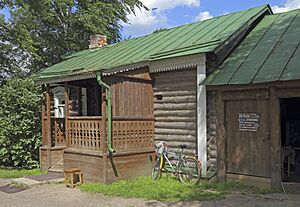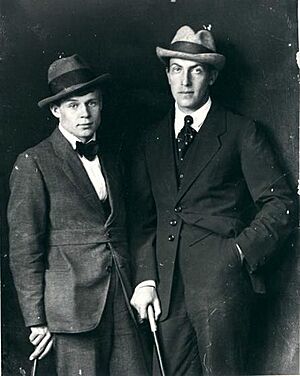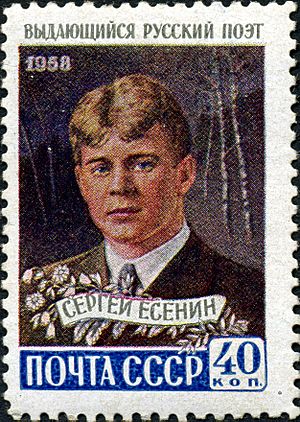Sergei Yesenin facts for kids
Quick facts for kids
Sergei Yesenin
|
|
|---|---|
| Сергей Есенин | |
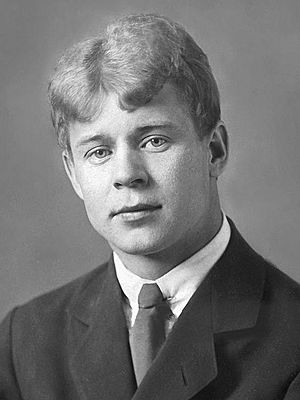 |
|
| Born |
Sergei Alexandrovich Yesenin
October 3, 1895 Konstantinovo, Ryazansky Uyezd, Ryazan Governorate, Russian Empire
|
| Died | December 28, 1925 (aged 30) Leningrad, Soviet Union (now St. Petersburg, Russia)
|
| Resting place | Vagankovo Cemetery, Moscow |
| Nationality |
|
| Occupation | Lyrical poet |
| Movement | New peasant poetry, Imaginism |
| Spouse(s) |
|
Sergei Alexandrovich Yesenin (Russian: Сергей Александрович Есенин October 3, 1895 – December 28, 1925) was a famous Russian poet. He is known for his beautiful poems about village life and nature. Many people consider him one of the most popular Russian poets of the 20th century. His poems often showed a longing for the simple life of the countryside.
Contents
Biography of Sergei Yesenin
Early Life and Education
Sergei Yesenin was born in 1895 in a village called Konstantinovo. This village was in the Ryazan Governorate of the Russian Empire. His parents, Alexander and Tatyana, were peasants.
Because his parents often left to find work, Sergei was raised by his maternal grandparents. They lived in the nearby village of Matovo. His grandparents were quite well-off.
Sergei spent his early years with his three uncles. He later remembered them teaching him how to ride horses and swim. He started reading at age five. By the time he was nine, he began writing poetry. He was inspired by folk songs and stories, especially those from his grandmother. She was a very religious woman. Sergei also had two younger sisters, Yekaterina and Alexandra.
In 1904, Yesenin started school in Konstantinovo. He finished in 1909 with good grades. Then he went to a local secondary school in Spas-Klepiki. From 1910, he started writing poetry regularly. He wrote about thirty poems during his school years. He tried to publish his first book of poems in 1912 but was not successful.
Moving to Moscow and Early Career
In 1912, Yesenin moved to Moscow with a teacher's diploma. He found work as an assistant at a printing company. The next year, he started studying history and language at Chanyavsky University. However, he had to leave after 18 months because he didn't have enough money.
While at the university, he met other young poets. In 1913, Yesenin married Anna Izryadnova, a co-worker. They had a son named Yuri. During this time, Yesenin became very interested in Christianity. He also got involved with groups in Moscow that wanted change. His apartment was even watched by the secret police for a few months.
In January 1914, Yesenin's first poem, "Beryoza" (The Birch Tree), was published. It appeared in a children's magazine called Mirok. More of his poems were published in other small magazines. In December 1914, Yesenin quit his job to focus completely on writing poetry.
Rise to Fame in Petrograd
In 1915, Yesenin moved to Petrograd because he felt his work wasn't getting enough attention in Moscow. He met the famous poet Alexander Blok, who liked his poems. Blok helped Yesenin become known in literary circles. He called Yesenin "a gem of a peasant poet."
Yesenin also met other important poets like Sergey Gorodetsky, Nikolai Klyuev, and Andrei Bely. He learned a lot from them. In 1916, his first poetry collection, Radunitsa, was published. It included many of his early spiritual poems. Yesenin and Klyuev became very close friends.
Yesenin quickly became famous in St. Petersburg. By the end of 1915, he was a star in the city's literary groups. He met other well-known writers like Maxim Gorky and Vladimir Mayakovsky.
Military Service and Revolutions
In March 1916, Yesenin was called for military duty. He joined a medical train unit. In July 1916, he recited his poems for Empress Alexandra Fyodorovna. He later recalled that the Empress found his poems beautiful but sad. Yesenin replied that the same could be said about Russia.
Yesenin supported the February Revolution of 1917. He also welcomed the rise of the Bolsheviks. He felt that the revolution helped him grow as a poet. However, he later criticized the Bolshevik government. He felt that the new socialism was different from what he had hoped for. He never joined the Communist Party.
In August 1917, Yesenin married for the second time to Zinaida Raikh. They had two children, a daughter named Tatyana and a son named Konstantin. They later divorced in 1921. Tatyana became a writer, and Konstantin became a well-known soccer statistician.
New Artistic Movements
The years of revolution were exciting for Yesenin's art. He wrote important poems like "The Advent" and "Transformation." In September 1918, Yesenin became friends with Anatoly Marienhof. Together, they started a new Russian literary movement called imaginism.
In 1919, Yesenin signed the Imaginists' Manifest. He and Marienhof also founded an Imaginist publishing house. Yesenin's books Mare's Ships and The Keys of Mary were published that year.
In 1920, Yesenin traveled through southern Russia. He visited cities like Rostov-on-Don and Tbilisi. He was briefly arrested by the Cheka (secret police) but was released. Several of his books were published during this time, including Confessions of a Hooligan and the play Pygachov.
Travels and Later Life
In May 1921, Yesenin visited his friend, the poet Alexander Shiryaevets, in Tashkent. He gave poetry readings there. In the fall of 1921, Yesenin met the famous American dancer Isadora Duncan. She was 18 years older than him. They married on May 2, 1922.
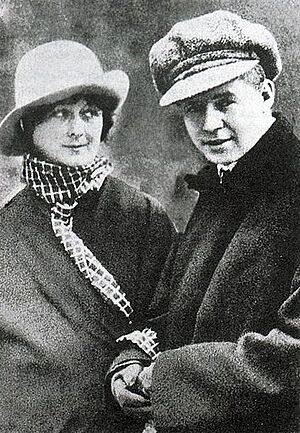
Yesenin traveled with Duncan on a tour of Europe and the United States. Their marriage was short, and he returned to Moscow in May 1923.
In 1923, Yesenin had a romantic relationship with actress Augusta Miklashevskaya. He dedicated several poems to her. He also had a son, Alexander, with the poet Nadezhda Volpina. Alexander Yesenin-Volpin later became a poet and a famous activist.
In 1924, Yesenin announced that the Imaginist movement was ending. In early 1925, he married Sophia Andreyevna Tolstaya. She was the granddaughter of the famous writer Leo Tolstoy. His final long poem, Anna Snegina, was published in May of that year.
Death and Legacy
On December 28, 1925, Sergei Yesenin was found dead in his hotel room in Leningrad. His last poem, Goodbye my friend, goodbye, was reportedly written the day before he died.
|
До свиданья, друг мой, до свиданья. |
Farewell, my good friend, farewell. |
Many biographers believe he was very sad and ended his own life. After a funeral in Leningrad, his body was taken to Moscow. He was buried on December 31, 1925, in Moscow's Vagankovskoye Cemetery. His grave has a white marble sculpture.
Some people believe that Yesenin's death was not a suicide but an assassination. The novel Yesenin. Story of a Murder explores this idea. The poet Vladimir Mayakovsky wrote a poem called To Sergei Yesenin in response to his death.
Cultural Impact and Recognition
Sergei Yesenin was one of Russia's most popular poets. He even had a large state funeral. However, some of his writings were banned by the government during the time of Joseph Stalin and Nikita Khrushchev.
Most of his works were republished only in 1966. Today, Yesenin's poems are taught to Russian schoolchildren. Many of his poems have been turned into popular songs. His early death and his passionate life have made him a legendary figure in Russian culture.
Several composers have set Yesenin's poems to music. The Ryazan State University is named in his honor.
Works by Sergei Yesenin
- The Scarlet of the Dawn (1910)
- The Birch Tree (1913)
- Autumn (1914)
- Russia (1914)
- A Song About a Dog (1915)
- I left the native home (1918)
- Hooligan (1919)
- Hooligan's Confession (1920)
- I am the last poet of the village (1920)
- Pugachev (1921)
- Land of Scoundrels (1923)
- A Letter to Mother (1924)
- Tavern Moscow (1924)
- A Letter to a Woman (1924)
- The Black Man (1925)
- To Kachalov's Dog (1925)
- Goodbye, my friend, goodbye (1925)
See also
 In Spanish: Serguéi Yesenin para niños
In Spanish: Serguéi Yesenin para niños


